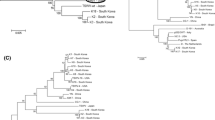Abstract
The complete genome sequence of a wild tomato mosaic virus (WTMV) isolate (named WTMV-Sn) was determined and identified in Solanum nigrum in China. The complete genome of WTMV-Sn is 9,659 nucleotides in length, excluding the poly(A) tail and encodes a polyprotein of 3,074 amino acids. This is the first report of WTMV infecting S. nigrum. Despite the high degree of sequence similarity between the WTMV-Sn and WTMV-XC-1 isolates, the 349 nucleotides at the 5′ terminus of WTMV-Sn appear to have originated by recombination with another isolate. The recombination parent remains unknown, but the recombination region shares 74.57% sequence identity with isolate WTMV-Laichau, which is below the species demarcation threshold for the genus Potyvirus. A pathogenicity test showed that WTMV-Sn can infect tobacco. This suggests that variation in the P1 cistron of WTMV-Sn may contribute to its ability to infect S. nigrum.

Similar content being viewed by others
References
Ha C, Coombs S, Revill PA, Harding RM, Vu M, Dale JL (2008) Design and application of two novel degenerate primer pairs for the detection and complete genomic characterization of potyviruses. Arch Virol 153(1):25–36
Du ZG (2014) First report of Wild tomato mosaic virus infecting tobacco (Nicotiana tabacum) in China. Plant Dis 98(6):856
Sun H, Liu W, Yang J, Wang F, Shen L, Li Y, Sun D, Qian Y (2016) Complete genome sequence of a novel wild tomato mosaic virus isolate infecting Nicotiana tabacum in China. J Phytopathol 164(9):686–690
Bedford ID, Kelly A, Banks GK, Briddon RW, Cenis JL, Markham PG (1998) Solanum nigrum: an indigenous weed reservoir for a tomato yellow leaf curl geminivirus in southern Spain. Eur J Plant Pathol 104(2):221–222
Hartl M, Merker H, Schmidt DD, Baldwin IT (2008) Optimized virus-induced gene silencing in Solanum nigrum reveals the defensive function of leucine aminopeptidase against herbivores and the shortcomings of empty vector controls. New Phytol 179(2):356–365
Sakthivel J, Lingan R, Haokip B, Krishnan N, Gandhi K, Manoranjitham SK (2018) First report of natural infection of Solanum nigrum L. with tomato mosaic virus in India. Plant Dis 102(5):1044
Adams MJ, Antoniw JF, Beaudoin F (2005) Overview and analysis of the polyprotein cleavage sites in the family Potyviridae. Mol Plant Pathol 6(4):471–487
Chung BY, Miller WA, Atkins JF, Firth AE (2008) An overlapping essential gene in the Potyviridae. Proc Natl Acad Sci USA 105(15):5897–5902
Adams MJ, Antoniw JF, Fauquet CM (2005) Molecular criteria for genus and species discrimination within the family Potyviridae. Arch Virol 150(3):459–479
Ronquist F, Teslenko M, Mark PVD, Ayres DL, Darling A, Höhna S, Larget B, Liu L, Suchard MA, Huelsenbeck JP (2012) MrBayes 3.2: efficient bayesian phylogenetic inference and model choice across a large model space. Syst Biol 61(3):539–542
Shi Y, Chen J, Hong X, Chen J, Adams MJ (2007) A potyvirus P1 protein interacts with the Rieske Fe/S protein of its host. Mol Plant Pathol 8(6):785–790
Jiang H, Li K, Dou D, Gai J (2017) Characterization of a soybean mosaic virus variant causing different diseases in Glycine max and Nicotiana benthamiana. Arch Virol 162(2):549–553
Salvador B, Saénz P, Yangüez E, Quiot JB, Quiot L, Delgadillo M, García J, Simón-Mateo C (2008) Host-specific effect of P1 exchange between two potyviruses. Mol Plant Pathol 9(2):147–155
Acknowledgements
We are very appreciative of Dr. Ralf Georg Dietzgen (Editor of Archives of Virology) for language editing. These studies were supported by the National Key Research and Development Plan, Project no. 2017YFD0301704, 2018YFD0201006, 2018YFD0200700; Research Foundation of Sichuan Provincial Education Department (035Z1038); Sichuan Provincial Science and Technology Project, Project no. 2016NYZ0053; Chengdu Science and Technology Project, Rapid Identification and Virus-Free Technology of Kiwifruit Virus.
Author information
Authors and Affiliations
Corresponding author
Ethics declarations
Conflict of interest
We have no conflict of interest to declare.
Additional information
Handling Editor: Ralf Georg Dietzgen.
Publisher's Note
Springer Nature remains neutral with regard to jurisdictional claims in published maps and institutional affiliations.
Electronic supplementary material
Below is the link to the electronic supplementary material.
Rights and permissions
About this article
Cite this article
Zhang, L., Shang, J., Jia, Q. et al. The complete genome sequence of wild tomato mosaic virus isolated from Solanum nigrum reveals recombination in the P1 cistron. Arch Virol 164, 903–906 (2019). https://doi.org/10.1007/s00705-019-04146-8
Received:
Accepted:
Published:
Issue Date:
DOI: https://doi.org/10.1007/s00705-019-04146-8




